Isotonic solutions Study guides, Class notes & Summaries
Looking for the best study guides, study notes and summaries about Isotonic solutions? On this page you'll find 2231 study documents about Isotonic solutions.
Page 4 out of 2.231 results
Sort by
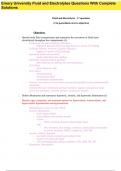
-
Emory University NRSG 533 Exam 1 Blueprint Adult and Gero QUESTIONS AND ANSWERS
- Exam (elaborations) • 18 pages • 2023
- Available in package deal
-
- $15.99
- + learn more
Fluid and Electrolytes - 17 questions (# in parenthesis next to objective) Objectives: 1. Identify body fluid compartments and summarize the movement of fluids (and electrolytes) throughout the compartments (1) - Hydrostatic Pressure (Capillary Filtration) - highest at arterial end (30 mmHg), lowest at venous (10 mmHg) - Colloidal Osmotic Pressure (Capillary Oncotic) - highest at venous end (28 mmHg) - Interstitial hydrostatic pressure - pushes fluid back into capillary - Interstitial...
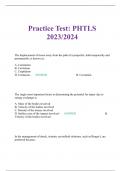
-
Practice Test: PHTLS 2023/2024
- Exam (elaborations) • 25 pages • 2023
- Available in package deal
-
- $10.49
- + learn more
Practice Test: PHTLS 2023/2024 The displacement of tissue away from the path of a projectile, both temporarily and permanently, is known as: A. Conization B. Cavitation C. Crepitation D. Contusion - ANSWER B. Cavitation The single most important factor in determining the potential for injury due to energy exchange is: A. Mass of the bodies involved B. Velocity of the bodies involved C. Density of the tissues involve...
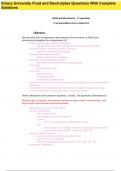
-
Emory University NRSG 533 Exam 1 Blueprint Adult and Gero QUESTIONS AND ANSWERS
- Exam (elaborations) • 18 pages • 2023
- Available in package deal
-
- $15.99
- + learn more
Fluid and Electrolytes - 17 questions (# in parenthesis next to objective) Objectives: 1. Identify body fluid compartments and summarize the movement of fluids (and electrolytes) throughout the compartments (1) - Hydrostatic Pressure (Capillary Filtration) - highest at arterial end (30 mmHg), lowest at venous (10 mmHg) - Colloidal Osmotic Pressure (Capillary Oncotic) - highest at venous end (28 mmHg) - Interstitial hydrostatic pressure - pushes fluid back into capillary - Interstitial...
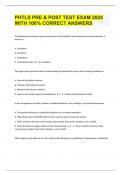
-
PHTLS PRE & POST TEST EXAM 2024 WITH 100% CORRECT ANSWERS
- Exam (elaborations) • 21 pages • 2024
-
- $17.49
- + learn more
The displacement of tissue away from the path of a projectile, both temporarily and permanently, is known as: A. Conization B. Cavitation C. Crepitation D. ContusionAnswer - B. Cavitation The single most important factor in determining the potential for injury due to energy exchange is: A. Mass of the bodies involved B. Velocity of the bodies involved C. Density of the tissues involved D. Surface area of the impact involvedAnswer - B. Velocity of the bodies involved ...
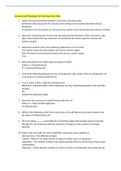
-
Anatomy and Physiology BIOD 151 Final Exam (35 Q&A)- Portage Learning 2023
- Exam (elaborations) • 3 pages • 2023
- Available in package deal
-
- $16.98
- 1x sold
- + learn more
1. Define the body movement involved in retraction and protraction: Retraction is the movement of a structure to be drawn in the posterior direction (drawn backward) Protraction is the movement of a structure to be drawn in the anterior direction (drawn forward) 2. Name the anatomical pair of terms that best describe the directions of the red arrows in the figure below (Note that two responses are needed for full credit): Superior (cranial) and inferior (caudal) 3. Determine whether each...
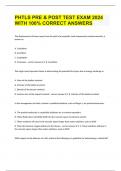
-
PHTLS PRE & POST TEST EXAM 2024 WITH 100% CORRECT ANSWERS
- Exam (elaborations) • 21 pages • 2024
-
- $17.49
- + learn more
PHTLS PRE & POST TEST EXAM 2024 WITH 100% CORRECT ANSWERS The displacement of tissue away from the path of a projectile, both temporarily and permanently, is known as: A. Conization B. Cavitation C. Crepitation D. Contusion - correct answer B. Cavitation The single most important factor in determining the potential for injury due to energy exchange is: A. Mass of the bodies involved B. Velocity of the bodies involved C. Density of the tissues involved D. Surface area...
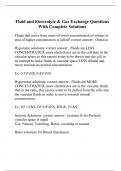
-
Fluid and Electrolyte & Gas Exchange Questions With Complete Solutions
- Exam (elaborations) • 46 pages • 2023
-
- $15.99
- + learn more
Fluids that move from areas of lower concentration of solutes to area of higher concentration is called? correct answer: Osmosis Hypotonic solutions: correct answer: Fluids are LESS CONCENTRATED, more electrolytes are in the cell than in the vascular space so this causes water to be drawn into the cell in an attempt to make fluids in vascular space LESS diluted and move towards its normal concentration. Ex: 0.33%NS, 0.45%NS Hypertonic solutions: correct answer: Fluids are MORE CONCEN...
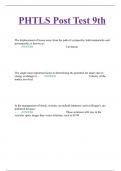
-
PHTLS Post Test 9th
- Exam (elaborations) • 20 pages • 2023
- Available in package deal
-
- $10.49
- + learn more
PHTLS Post Test 9th The displacement of tissue away from the path of a projectile, both temporarily and permanently, is known as: - ANSWER Cavitation The single most important factor in determining the potential for injury due to energy exchange is: - ANSWER Velocity of the bodies involved In the management of shock, isotonic crystalloid solutions, such as...
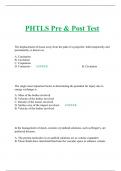
-
PHTLS Pre & Post Test
- Exam (elaborations) • 26 pages • 2023
-
- $10.49
- + learn more
PHTLS Pre & Post Test The displacement of tissue away from the path of a projectile, both temporarily and permanently, is known as: A. Conization B. Cavitation C. Crepitation D. Contusion - ANSWER B. Cavitation The single most important factor in determining the potential for injury due to energy exchange is: A. Mass of the bodies involved B. Velocity of the bodies involved C. Density of the tissues involved...
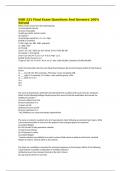
-
NUR 231 Final Exam Questions And Answers 100% Solved
- Exam (elaborations) • 100 pages • 2024
-
- $18.59
- + learn more
NUR 231 Final Exam Questions And Answers 100% Solved What are the normal's for the following labs 1) Urine Specific Gravity 2) Serum Osmolality 3) ABG (pH, HCO3, PaCO2, PaO2) 4) troponin I 5) electrolyte panel( Na+, K+, Ca+, Mg+) 6) BUN & Creatinine 7) CBC ( hgb, hct, RBC, WBC, platelets) 1) 1.000-1.030 2) 270-300 3) pH 7.35-7.45// HC03 22-26// PaCO2 35-45// Pa02 80-100 4) troponin I <0.03 ng/mL 5) Na+ 135-145//K+ 3.5-5// Ca+ 9-10.5//Mg+ 1.2-2 6) BUN 10-20//Creat 0.5-1.2 7) hg...

$6.50 for your textbook summary multiplied by 100 fellow students... Do the math: that's a lot of money! Don't be a thief of your own wallet and start uploading yours now. Discover all about earning on Stuvia


